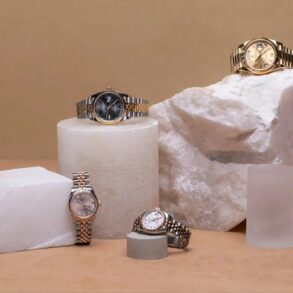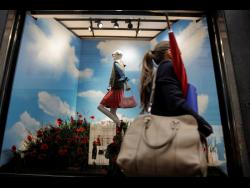
Finally, the wait is over.
On Friday afternoon, Gucci’s new creative director Sabato de Sarno sent a confident collection of pared-back looks down the runway in his Milan debut. It was just what Gucci needed, and parent Kering SA’s shares rose as much as 4%.
While the de Sarno era has got off to a promising start, the question now is whether the clothes and accessories will be striking enough to reignite interest in Kering’s biggest brand, whose garish prints and logo-heavy styles had fallen out of favor with consumers, leaving sales growth to lag rivals.
In contrast to former creative director Alessandro Michele’s bold maximalism, de Sarno presented a minimalist selection, with split pencil skirts and chic tailoring, in line with the current trend for “quiet luxury.” The clothes felt fresh, with standout pieces including slip dresses with heavy lace trimmings.
Yet he didn’t throw out the “Gucciness.” Playsuits, shoes and bags retained the double-G logo, while the traditional Gucci horsebit was also in evidence.
This is important because it will take time for de Sarno’s full collection to reach stores. In the meantime, shoppers will still feel at ease purchasing Jackie bags and horsebit loafers, whereas there’d be no point making an investment if the product will be immediately superseded.
De Sarno’s looks should help Gucci rebalance its customer base and appeal to more older and upmarket shoppers, prepared to pay higher prices. many of whom didn’t warm to Michele’s designs. But can “Ancora” as the collection is known, be eye-catching enough to turn fashionistas back onto Gucci?
While there were many wearable pieces, de Sarno’s designs lacked the overt sexiness of Tom Ford and the innovation of Michele. When the latter’s designs hit the catwalk in 2015, they shattered the minimalism that had prevailed in the industry — and initially rewarded Kering with stellar sales growth. Gucci tends to work best when it’s larger than life, and it’s not clear whether de Sarno’s vision is bold enough to revive demand for Gucci shoes and handbags, the real profit drivers of luxury.
Much will depend on how the collection is merchandized — which pieces from the catwalk will appear in stores and online — and how it is marketed (for example, which celebrities are spotted wearing the brand).
There is an awful lot riding on this transformation. Gucci generated revenue of about €10.5 billion ($11.2 billion) last year, accounting for about half of Kering’s sales and about two-thirds of the company’s operating profit. Meanwhile, Balenciaga, another formerly fast-growing division, was hit by an advertising scandal last year, and Kering recently announced that Sarah Burton, who designed the Princess of Wales’s wedding dress, was leaving Alexander McQueen after more than two decades.
One danger to de Sarno’s Gucci is that it will be compared with the Michele era, whose turnaround was nothing short of remarkable. If de Sarno fails to achieve quite the same momentum, he may be judged by investors and commentators to have fallen short. The current state of the luxury industry, marked by a slowdown in the US and a lackluster recovery in China, also makes his task more challenging.
Ancora is Italian for “again.” Gucci certainly needs to reinvent itself once more. Future seasons must build on the impressive debut. But the first glimpse of the new Gucci, and investors’ reaction to it, bode well for a third turnaround.
More From Bloomberg Opinion:
• The Golden Days of Buy-to-Let in the UK Are Over: Merryn Somerset Webb
• Burberry Gets Its Confidence Back in London: Andrea Felsted
• Italy Ruins Beach Time for Bankers: Rachel Sanderson
This column does not necessarily reflect the opinion of the editorial board or Bloomberg LP and its owners.
Andrea Felsted is a Bloomberg Opinion columnist covering consumer goods and the retail industry. Previously, she was a reporter for the Financial Times.
More stories like this are available on bloomberg.com/opinion
©2023 Bloomberg L.P.
This post was originally published on this site be sure to check out more of their content.





